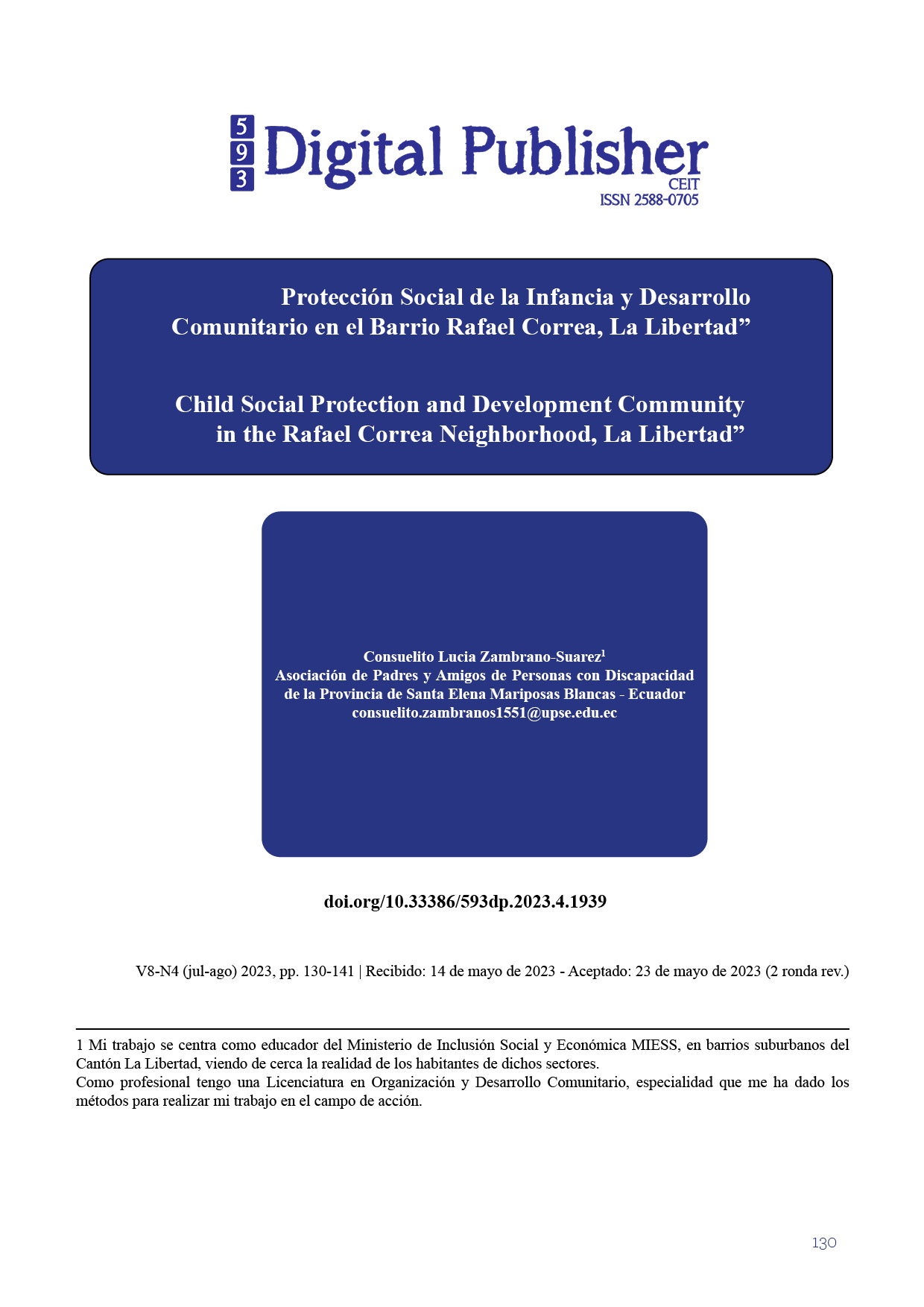Child Social Protection and Development Community in the Rafael Correa Neighborhood, La Libertad”
Main Article Content
Abstract
The present investigation had as a general objective to determine the relationship between social protection and community development of children from the Rafael Correa neighborhood, La Libertad.
The type of research was a mixed study type, which includes the quantitative method, because the tabulated data from the surveys will be analyzed, and the qualitative one, because we will look for specific characteristics of the population with the objective of finding the solution in this investigation, in addition to The direct observation method was used to obtain information on the facts, cases or people in their natural environment, and the ethnographic method was also used, a method by which it allowed us to learn about their life customs.
Additionally, for the collection of information of the present investigation, the exploratory method will be used and by secondary sources, coming from public institutions such as the National Institute of Statistics and Censuses, Ministry of Economic and Social Inclusion. Our population is 45 families from the sector (who are in the CNH program), and they will be part of our sample, because they are all involved in this investigation, and an interview is conducted with 3 members of the neighborhood who are leaders and neighborhood president.
The research technique used to collect information was the survey, as an instrument the questionnaire with a Likert scale of 15 items was used, which were validated through reliability tests in the SPSS program, by means of Cronbach's Alpha to determine that if the variables under study are related, and that have high reliability of the study of the hypothesis.
According to the research carried out, we concluded that the value of the social protection and social development coefficient is 0.384, which indicates that it is a high and direct correlation and also that H1 is accepted: Social protection and community development do have effects positive in the learning of children in the Rafael Correa sector, La Libertad, that is to say that if changes are made in the education and protection of children, community development will also take place.
Downloads
Article Details

This work is licensed under a Creative Commons Attribution-NonCommercial-ShareAlike 4.0 International License.
1. Derechos de autor
Las obras que se publican en 593 Digital Publisher CEIT están sujetas a los siguientes términos:
1.1. 593 Digital Publisher CEIT, conserva los derechos patrimoniales (copyright) de las obras publicadas, favorece y permite la reutilización de las mismas bajo la licencia Licencia Creative Commons 4.0 de Reconocimiento-NoComercial-CompartirIgual 4.0, por lo cual se pueden copiar, usar, difundir, transmitir y exponer públicamente, siempre que:
1.1.a. Se cite la autoría y fuente original de su publicación (revista, editorial, URL).
1.1.b. No se usen para fines comerciales u onerosos.
1.1.c. Se mencione la existencia y especificaciones de esta licencia de uso.
References
Araujo, M. (2020, marzo 2). Los desafíos del desarrollo infantil en América Latina y el Caribe. Primeros Pasos. https://blogs.iadb.org/desarrollo-infantil/es/desafios-desarrollo-infantil- América-latina-y-caribe/
Caribe, C. E. para A. L. y el. (2014). Infancia y (des)protección social: Un análisis comparado en cinco países latinoamericanos. CEPAL. https://www.cepal.org/es/publicaciones/37327-infancia-desproteccion-social-un-analisis- comparado-cinco-países
Castellanos, L. (2017, marzo 2). Técnica de Observación. Metodología de la Investigación. https://lcmetodologiainvestigacion.wordpress.com/2017/03/02/tecnica-de-observacion/
CEPAL UNICEP. (2020). Protección social para familias con niños, niñas y adolescentes en América Latina y el Caribe: Un imperativo frente a los impactos del COVID-19 | Publicación | Comisión Económica para América Latina y el Caribe. https://www.cepal.org/es/publicaciones/46489-proteccion-social-familias-ninos-ninas- adolescentes-América-latina-caribe-un
Duran, A. (2023). Protección a los Menores de Edad – Derecho Ecuador. https://derechoecuador.com/proteccion-a-los-menores-de-edad/
IBM. (2022, octubre 5). IBM Documentation. https://www.ibm.com/docs/es/spss- statistics/SaaS? Topic=tests-one-sample-Kolmogorov-Smirnov-test
León, M. (2017). Protección social de la niñez en el Ecuador. https://repositorio.cepal.org/handle/11362/41233
López, P. L. (2004). POBLACIÓN MUESTRA Y MUESTREO. Punto Cero, 09(08), 69-
Oviedo, H. C., & Campo-Arias, A. (2005). Aproximación al uso del coeficiente alfa de
Cronbach. Revista Colombiana de Psiquiatría, 34(4), 572-580.
Sepúlveda Carmona, M. (2014). De La Retórica a La Práctica: El Enfoque De Derechos En La Protección Social En América Latina (From Rhetoric to Practice: Rights-Based Approach Social Protection in Latin América). CEPAL-Serie Políticas Sociales, (189)
Tapia, C. E. F., & Cevallos, K. L. F. (s. f.). PRUEBAS PARA COMPROBAR LA NORMALIDAD DE DATOS EN PROCESOS PRODUCTIVOS: ANDERSON-DARLING, RYAN-JOINER, SHAPIRO-WILK Y KOLMOGÓROV-SMIRNOV. Societas. Revista de
Ciencias Sociales y Humanísticas, 23(2), 83-106.
UNIR. (2020). Estimulación temprana: Qué es y cuáles son sus ventajas. UNIR. https://www.unir.net/educacion/revista/estimulacion-temprana/


